A study published earlier this month in the journal Nature Communications explores patterns of sperm whale communication that may point toward culture-like exchanges in the species.
By comparing 18 years of collected whale song data from the eastern Pacific Ocean, the study found social communication structures intricate enough to put whales in the “complex communication” camp occupied by humans, other primates and elephants.
The study found that variations in the songs sung by different groups of sperm whales are neither genetic nor random but learned. According to University of Dalhousie’s Mauricio Cantor and his team, these variations are only explainable if whales consciously pick up the patterns of “speech” from structured social groups to which they belong.
The authors observed great similarity in the acoustic signals shared by members of specific social groups. This, combined with the lack of acoustic similarity between different social groups indicates that sperm whales, like primates, humans and elephants, learn the dialects (particular to each group), rather than acquiring them as a heritable trait.
The study compares sperm whale communities to human cultures: variations in song vernacular are used to differentiate conversation between individuals from that between families or even larger groups (clans) of whales with a shared migration pattern. The study describes this behaviour as “hierarchically nested social levels.”
“These findings,” the study’s authors write, “suggest that processes similar to those that generate complex human cultures could not only be at play in non-human societies but also create multi-level social structures in the wild.”
Such complex patterns of communication have been noted in other species as well — most famously other primates and elephants.
The concept of interspecies communication has also been on the scientific radar for decades. In the 1960s, scientist John Lilly predicted that it would only be a few years before humans established meaningful communication with the marine mammals.
A decade later, Louis Herman conducted experiments that indicated dolphins were capable of understanding not only vocabulary (presented in the form of an invented sign language), but also the grammatical mechanics of vocabulary combinations. That is, the dolphin could distinguish between the command “surfboard person fetch,” and “person, surfboard fetch,” according to National Geographic’s Ed Yong.
Today, comprehension has been established for five decades, but communication remains surficial. Stan Kuczaj, a psychologist who studies dolphin cognition at the Roatan Institute for Marine Sciences (RIMS), is hopeful that the key to unlocking dolphin communication is just around the corner.
Justin Gregg, a research associate with the Dolphin Communication Project, is more skeptical. “The ever-present scientific caveat that ‘there is much we do not know’ has allowed dolphinese proponents to slip the idea of dolphin language in the back door,” Gregg writes.
“The sophistication of dolphins that makes them so interesting also makes them really difficult to study,” Kuczaj told National Geographic’s Joshua Foer. After 18 years of data collection and analysis, Cantor and his team’s sperm whale study may share that sentiment.









